Purchase Orders
Purchase Orders is the basic document in the module Purchase, from which the subordinate documents Invoice In Delivery Confirmation and Receipt Card are derived. The exception to this rule are only the so called free documents. Z: In light of the optimal information processing, it is advantageous to interpret one Purchase Order as one business transaction that can be closed separately.
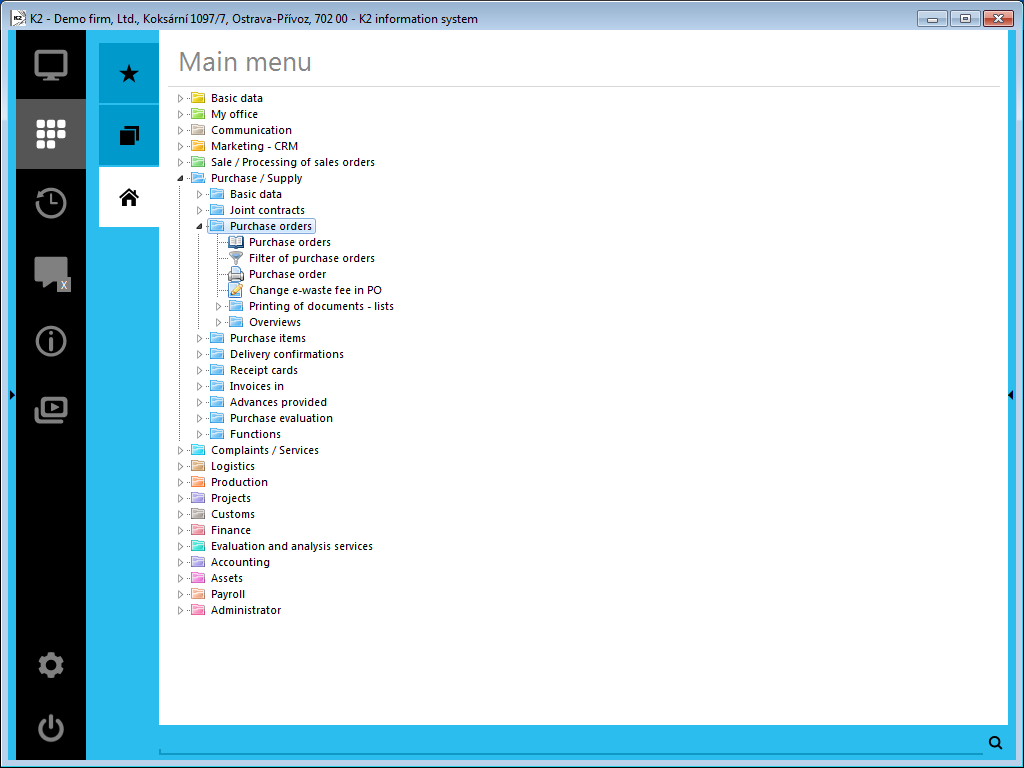
Picture: Open menu of the Purchase/Supplying - Purchase Orders module
Book of Purchase Orders
It is convenient to divide larger shipment into individual sub-orders and have them joined by means of the Contract Code field into one unit. In this way, it is also possible to join the purchase order from various books, branches, cost centres etc. into one unit.
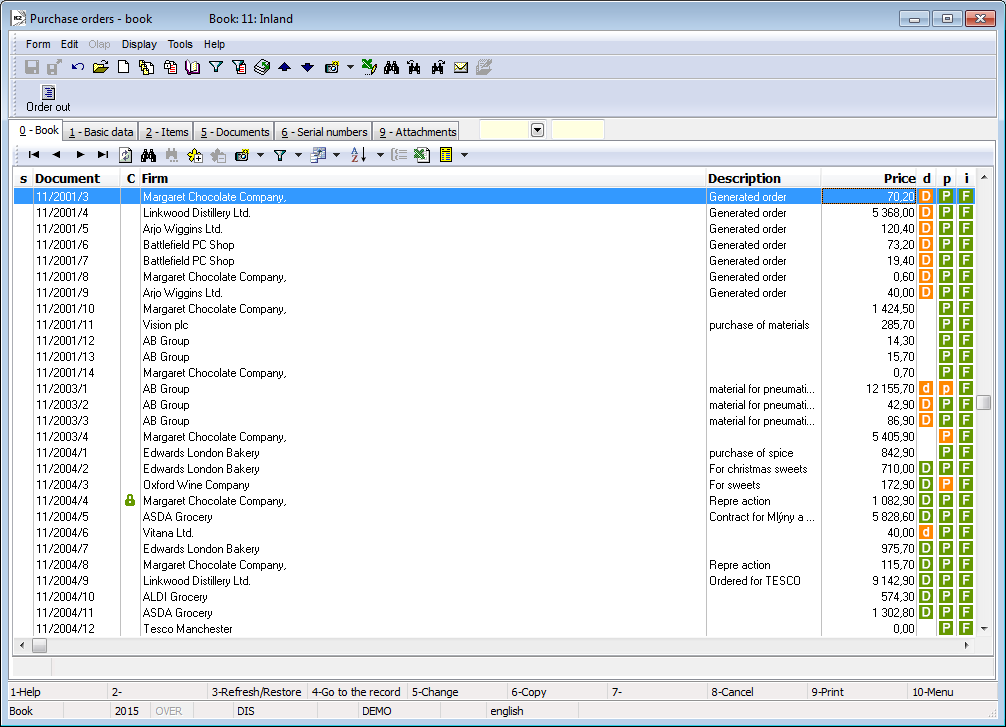
Picture: Purchase Order book
Purchase Order Document
Basic data (1st page)
On the 1st page of the Purchase Order document are basic data that create the so-called 'document heading'. The heading data (first three rows) are also displayed on the other pages of a document.
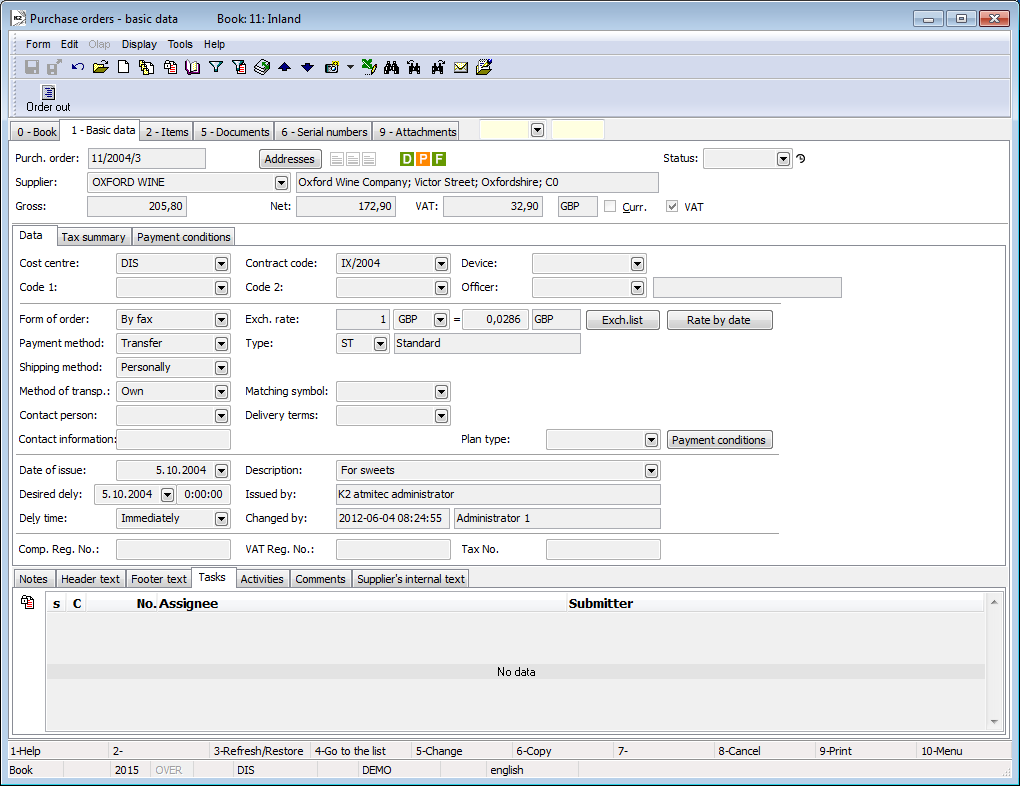
Picture: Purchase Orders - 1stpage
Field Description:
Order confirmation |
The Book, Business Year and Number of a Purchase Order. |
Addresses |
The button displays an addressee and superior companies. For further information, see the Addressee chapter. |
Status |
Field for selection from a code list. This field enables to filter a document according to the selected status that the user has selected. |
Supplier |
Basic data about Supplier. In this field there are displayed the data that are set on the 3rdpage inthe Client parameters. Client parameter. It can be e.g. an Abbreviation, a Name, a Country, a Place, a Price group, etc. |
Prices |
The data about purchase order prices - the gross price, the net price, VAT and the currency code items. |
Currency |
The option is automatically checked according to the entered currency on a document. |
VAT |
The option indicates that the Purchase Order is issued with VAT. |
In the lower part of the form, it is possible to work with notes and supplements by using the Notes, Header Text or Footer Text tabs. Further description of the work with attached documents and ext. documents is stated in the Basic Code Lists and Supporting K2 Modules - Notes chapter. Supplier Internal Text tab serves to display the supplier's internal text. Then you can use the folders Tasks and Activities. Closer description of work with the folders is stated in the Tasks - Document Folder and Activities - Document Folderchapters.
The payment conditions can be displayed on the Payment Conditionstab and they can be edited by means of the same button.
The basic data of the Purchase Order header are divided into several tabs.
The Data tab contains basic information of the document header.
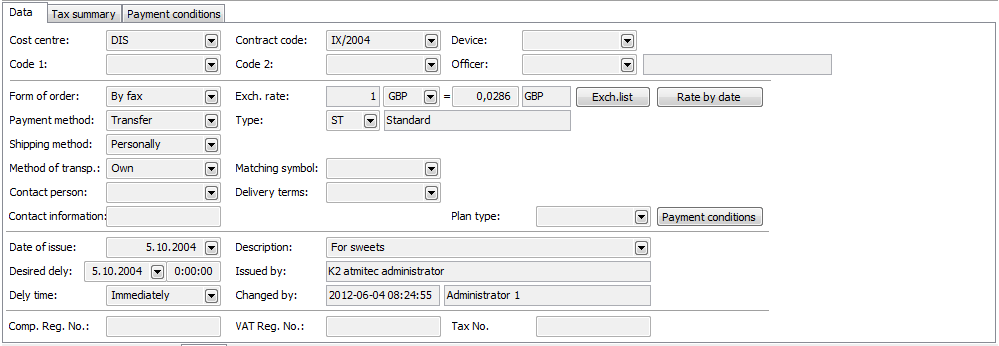
Picture: Data - Purchase Order - (page 1)
Field Description:
Cost Centre |
Selection from the Cost Centres code list. This will enter the Cost Centre that issues the Order. |
Contract code |
The selection from the Contract Codes code list. It is used for distinguishing the Orders. |
Device |
Reference to the Device Book. It is copied fromthe Purchase Order into the subordinate documents. |
Code 1, Code 2, Officer |
The fields enable the user identification, eventually a link to the Officers book. Further description is stated inthe Basic Code lists - Code 1, Code 2, Officer chapter. |
Form of order |
The way how the Order was made. |
Payment Method |
The payment method for purchased articles - in cash, by bank transfer, by cash on delivery, etc. |
Shipping Method |
Shipping method of articles. |
Method of Transport |
Method of transport of articles. |
Contact Person |
A contact person on the page of Supplier. The link to the Contact Persons book. Tip: When pressing the keys Ctrl + Spacebar, only the contact persons of a given supplier will appear. |
Contact information |
The field can remain empty or you can write there your own text. |
Specific symbol |
Specific symbol. |
Exchange Rate |
The currency the Order is issued in. In this field, the exchange rate between a basic currency and the currency of the order is also displayed. |
Exchange List |
This button opens the Exchange List, where you can select from the defined exchange rates. The light indicator is positioned on the exchange rate that is valid to the date of issuing the document. The exchange rates are defined in the Currency code list. |
Exchange Rate According to the Date |
This button inserts the rate from the exchange list valid to the date of document issuing. It is activated only in the Change mode. |
Type |
The type of tax. The type of tax. It is filled into the document from the Suppl./Cust. card. (if it is entered here) or from the Book of Purchase. |
Matching Symbol |
Data about the matching symbol. It is further used in the accounting. |
Payment Conditions |
The button for switching the display to the payment conditions table. |
Plan type |
The selection from a Plan Type code list. The Plan Type that is defined in the Books of Purchase book on the 1st page in the Plan Type field is entered by default into the new documents. |
Regist. no. |
Supplier Comp. Reg. No. If not entered, the Comp. Reg. No from the Supplier card is valid. |
VAT reg.no. |
Supplier VAT Reg. No. If not entered, the VAT Reg. No. from the Supplier card is valid. |
Tax No. |
Tax number of the Supplier. If not entered, the Tax No. from the Supplier card is valid. |
Date of Issue |
The date of doc. issue. |
Required |
The date until which the articles must be delivered. |
Delivery Time |
The time limit within which the articles are to be delivered. |
Description |
The Order random description. |
Issued by |
The name of the employee who issued the Order. |
Changed |
The date and name of the user who made the last change. |
There is a table of a price recapitulation in the Tax Summary tab.
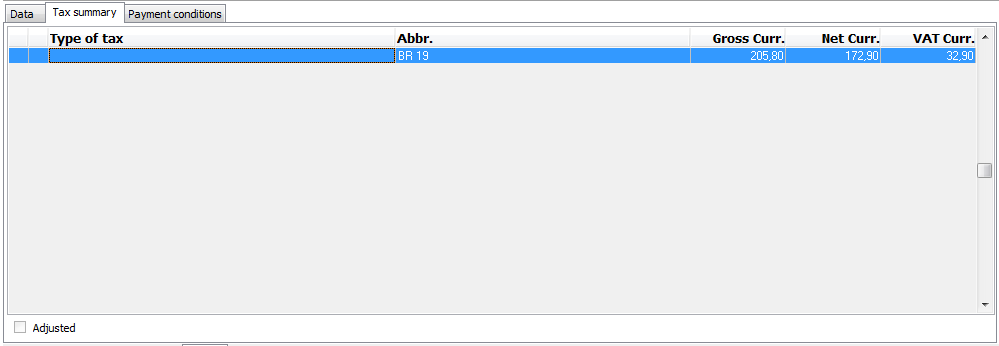
Picture: Tax Summary - Purchase Order (1st page)
Items (2nd Page)
There are items that are subject to purchase on the 2ndpage of the Purchase Order. Insert a new item in the Change mode or when creating a New Record by pressing Ins key by pressing which the Purchase Item form will be displayed. Display the same form by marking the selected item with a light indicator on a Purchase Order and by pressing the Enter key.
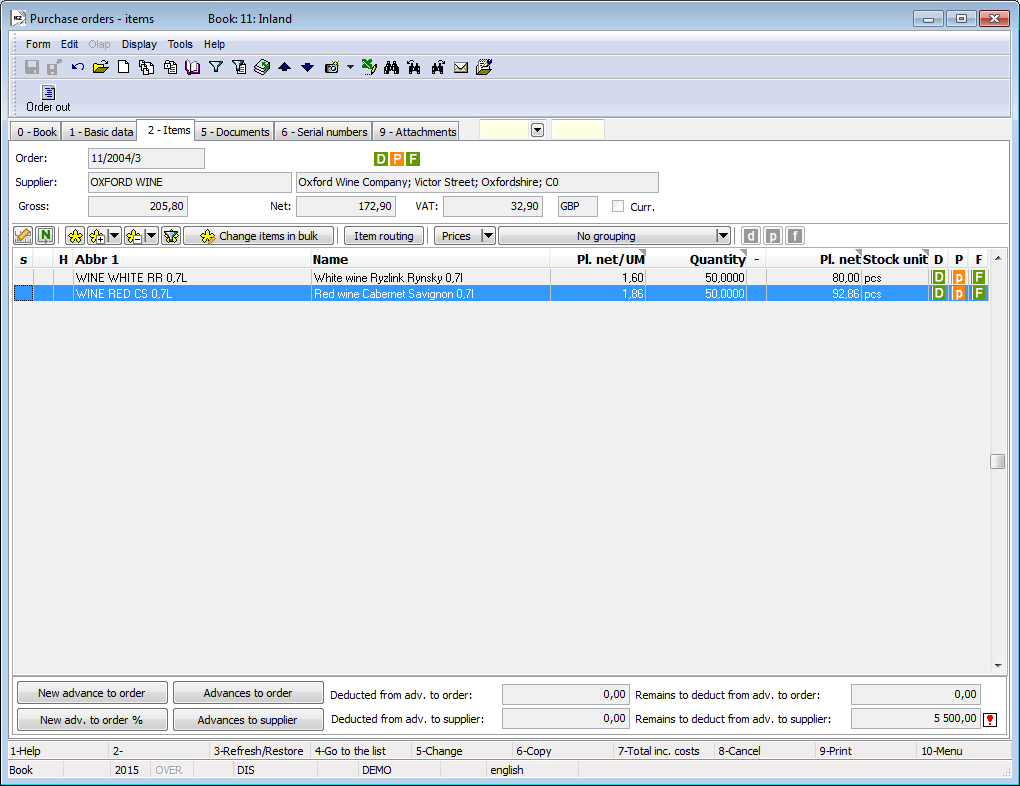
Picture: Purchase Orders - 2ndpage
Values in the documents items including discount, can be adjusted in bulk by means of Bulk Change of Items button in the Change mode. For further description of this function, see the Bulk Change of Document Items and Purchase and Sale Items chapters.
In the lower part of the 2nd page of a purchase order are the buttons related to the advances provided. The amounts are stated in the currency of a purchase order.
Selected fields description:
New Advance to Purchase Order |
The button for creating a new Advance Provided with pre-filled data forma Purchase Order. Purchase Order |
New Advance to Purchase Order in % |
The button for creating a new Advance Provided with pre-filled data forma Purchase Order. Purchase Order Enter amount of the Advance in %. |
Advances to Purchase Order |
The button for displaying the Advances to a Purchase Order. |
Advances to Supplier |
The button for displaying the Advances to a supplier. |
Deducted from adv. to purchase order |
Amount of the Advances to Purchase Order which has already been deducted on an Invoice. |
Deducted from adv. to supplier |
Amount of the Advances to a Supplier which has already been deducted on an Invoice. |
Remains to deduct from adv. to purchase order |
Amount of the paid Advances to a Purchase Order which has not been deducted on an Invoice yet. |
Remains to deduct from adv. to supplier |
Amount of the paid Advances to Supplier which has not been deducted on an Invoice yet. |
Description of Advances Provided may be found in the chapter Advances Provided.
Documents (5th Page)
The 5th page of the Purchase order shows an overview of all documents which are linked with this document. You can move between the individual documents by pressing the Ctrl key and the initial letter of the document simultaneously. It is also possible to display the selected document by pressing the Enter key.
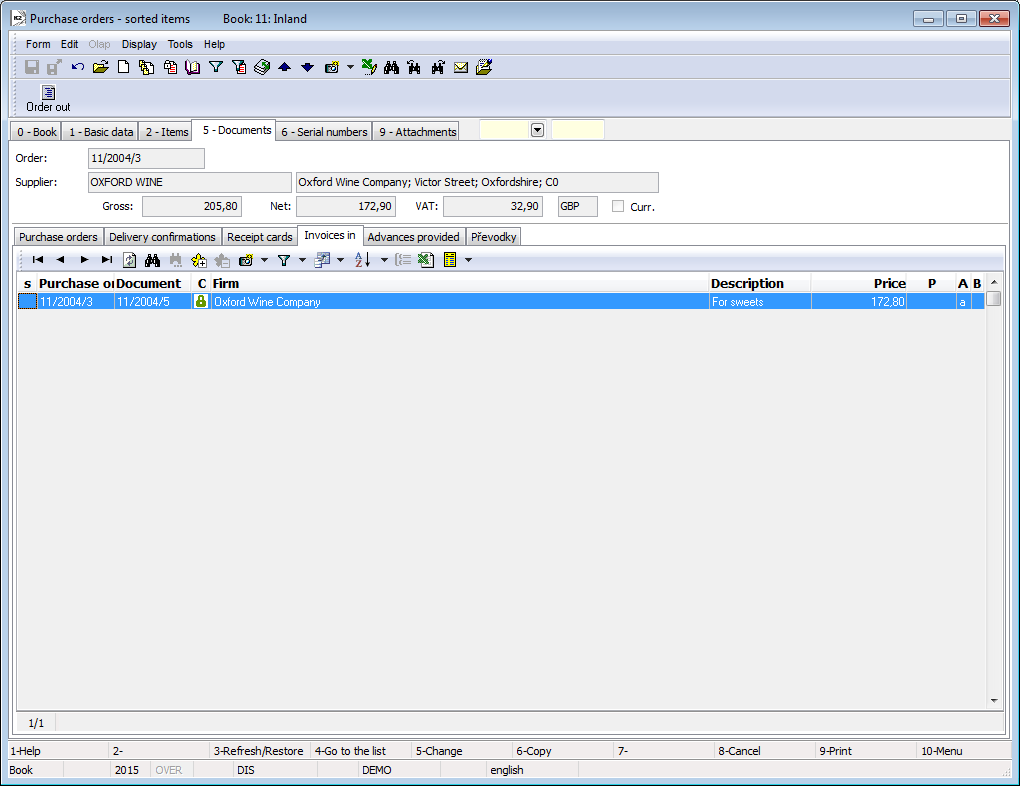
Picture: Purchase Orders - 5th page with the open tab Invoices In
Ext. Documents (9th page)
As withother documents in the K2 IS, it is possible to insert and link references to documents on the 9th page of orders. Further description of the work with This page is stated in The chapter Basic Code Lists and Supporting K2 Modules - 9th page
Functions of Invoices Out module menu
Form - Bulk Actions
Bulk actions can be run on records marked by asterisks or on records in container.
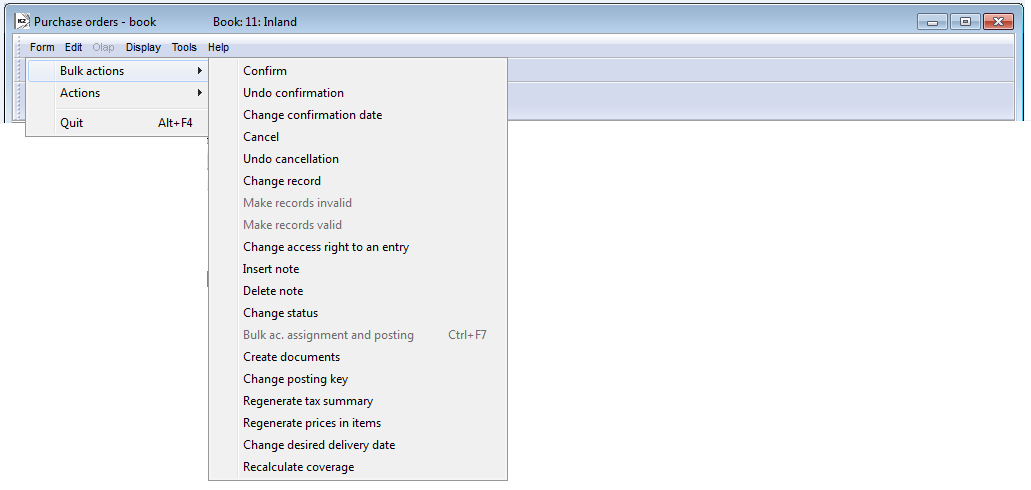
Picture: Functions of Invoices Outmodule menu
Form - Bulk Actions:
Change status |
It allows to bulk change the Status field of the selected entries. |
Change Desired Delivery Date |
The function enables to change the following data in Purchase orders:
VAT and Gross amounts will be recalculated after changing the VAT rate. If there is an unconfirmed subordinate document on the purchase order item, then the amount on the subordinate document will also be changed. |
Functions over Invoices Out
Order Cancellation (F8)
If the order has already been saved (has its own number), it cannot be deleted. Only unconfirmed orders can be cancelled with the F8 key. A cancelled order remains in the database with its content untouched and it only has the cancellation flag. It is therefore always possible to find out what its content was. A cancelled order cannot be edited, which is similar to the confirmation.
If the order contains confirmed subordinate documents, it cannot be cancelled. If the order contains unconfirmed subordinate documents, the program will ask whether the subordinate documents should be also cancelled. If the user has the required right, all documents will be cancelled simultaneously.
Purchase Orders Reports
Request for Quotation
Process No.: CRM005 |
Report ID: SCRM034 |
File: OBV_DOK02: |
Report description: Request for Quotation (Purchase Order without the price). The report enables to save parameters into the "*.xml" file. The bulk export into the "*.pdf" file and sending by email are possible. |
||
Address in the tree: [Purchase / Supplying] [Requests for Quotation] [Print documents - Evaluation] |
||
Parameters used:
BarCode - YesYes - a bar code is displayed. |
Batch - No Yes - batches for an item are displayed. |
BatchAttr - 0 0 - nothing is displayed; 1 - batch parameters are displayed; 2 - required batch parameters are displayed. |
BusinessRegister - 1 Information about the Business register fromthe Administration of own companies is displayed. Own comapanies settings 0 – does not display information about the Business register, 1 – displays text about Business register of maximum two rows, 2 – displays text about Business register of maximum four rows. |
CombineOrigItem - Yes Yes - combines the items with the same "OrigItemF" (if it is not different in price and the other attributes). |
Contacts - 1;Addr;TaxNum;Tel1;Fax1;Email1;WWW The parameter has 10 places, only the first three are fixed: 1st: the user whose contacts are printed from the user card (phone, mobile phone, fax, email). Options: 0 - no user contacts, 1 - the user who has issued the doc., 2 - the currently logged-in user who prints the documents. 2nd place: "Addr" - if entered, the company address will be displayed.
3rd place: "TaxNum" - if entered, then ID - No. and VAT Reg.No. will be displayed.
4. - 10th place: named types of electronic addresses of own companies (i.e. there can be up to 7). Example: (Contacts - 1;Addr;;TEL1;FAX1;WWW1): The company address will be displayed. The contacts from the user card of the user who issued the document will be stated below (tax numbers are skipped by an empty string on the 3rd place), then there are electronic addresses with Tel1 type, Fax1, WWW1.
Note: If any data is suppressed, there is no free place remaining. Nevertheless, the default order in a report is always as follows: the address, tax numbers, user's contacts and entered electronic addresses of own company. |
DefaultExport - No It is described along with other export parameters in the Report parameters for bulk sending by email chapter. |
Description - No Yes - it displays information from the Description field from the 1st page of the document. |
DescriptionFromItem - Yes Yes - a supplement that is entered into the Description field on a document item is displayed. |
DraftLabel -Yes Yes - a "DRAFT" is displayed at the background of the report if a document is not confirmed. No - a "DRAFT" is not displayed. |
Export_... - various parameters The report also includes export parameters described collectively for all documents in Report parameters for bulk sending by email chapter. |
Interactive - No No - an input form to enter parameter values is displayed. |
K2Info - Yes Yes - displays informative text about the document issued by the K2 system. |
KeepEnvelopeFormat - No No - the empty place is hidden under the place for the envelope window. The saved place is multiplied if the "ShowBarCode" parameter is set on "No". This is useful when the user does not use the envelope window and does not want to fold the printed documents into envelopes by the line on the document.
Yes - the place is not hidden - lines between items and the address part will be always in a one-third of a page. |
LangAccordToParams - No If the report is printed in the language that is set in the "Field language" and "Report language" parameters, then you have to set the value of the parameter to "Yes". |
LeftEnvelopeWindow - No Yes - the customer address is printed on the right side (intended for sending documents by mail in abroad, where the window for the envelope is onthe left side); No - the customer address is on the left side. |
LeftShift - 5 By how many mm the edge of the report is shifted to the left (used for setting up printing on the printer). |
LogoPictureFooter - 0 The parameter corrects the footer logo. If the parameter is empty, the footer logo is displayed according to the parameter settings Picture in Footer in the function Administrator - Administration of Own Companies. 0 - nothing is displayed, but there is a free place (for a header paper), 1 - neither picture nor free place. File name with png suffix - particular picture in Pictures directory of a particular company. |
LogoPictureHeader - The parameter corrects the header logo. If the parameter is empty, the header logo is displayed according to the parameter settings Picture in headerin the functionAdministrator - System - Administration of own companies. 0 - nothing is displayed, but there is a free place (for a header paper), 1 - neither picture nor free place. The condition is to set the parameter KeepEnvelopeFormat to No. File name with png suffix - particular picture in Pictures directory of a particular company. |
Notes - Enter the comment type from the document header which is to be displayed in the report into the parameter. To display more comment types, it is necessary to separate the individual types by using the semicolon (e.g. MAIL;CMR). If more comments of the same type are found, all of them are displayed. |
NumberOfItem - 2 0 - no number is displayed, 1 - number of a sales order item is displayed; 2 - order number is displayed. Always in the "#001" format. |
OneLineItem - No Yes - document item is always displayed on the 1st line. |
ProportionalFont - Yes Yes - displays the supplements by the Verdana font, No - CourierNew type of font. |
Reminder - No Yes - displays the texts for RFQ reminder. |
SerialNumber - No Yes - serial numbers for items are displayed. |
Sign - @Vyst;;; The parameter has five places: 1st one marks the person, whose signature will be displayed. It can be the picture named by the user's Logname, who has issued the doc (@Vyst) or who has printed it - or according to the current login (@akt) or particular Logname.
The value entered in the Stamp field in Administration of Own Companies is used by default. The path and the name of the file is entered here. The path may be entered by using the alias. Instead of entering the specific file name, it is possible to use %s. The picture must always be in the xxx.png format. If it is not filled in the Administration of Own Companies, the file will be searched in the Picturesdirectory.
An example of entered task in the Stampfield in Administration of Own Companies: via alias: k2*DEMO\Pictures\stamp.png (searches the picture in the Client's path. File stamp.png in The picture directory) via %s: k2*DEMO\Razitka\%s.png (the value entered this way enables to display signed bitmaps to all users who issue documents or are currently logged in and have the file in the PNG format in the directory (in this case the user created Stamp directory). 2nd: height of picture. 3rd: distance from the left corner. 4th: distance of picture from the upper corner of the given section. 5th: width of picture. Example: (Sign - @vyst;27;47;0;83) prints the signature of the user who has issued the document, height is 27 points, left indentation of 47 points, by the upper corner. The picture is 83 points wide. |
SortBy - The field is filled with the value of the field from the sales items (e.g. C_Zbo;Zkr or CF_CeJePlM). Items on a document are sorted according to the parameter value. The parameter is empty by default. If the value of this parameter is specified, then the items are not combined, even if the CombineOrigItem parameter is set to Yes. |
SupplFromArticles - 0 - Nothing is displayed, Empty value - a Business Text from an Article card is displayed. If the parameter is filled in, and if there is an existing comment type on the Article card that is identical to the parameter value, the text of this comment is displayed. If the given comment type does not exist, the entered type of supplement from the notes on the Article card will be displayed (e.g. the DB type). If both comment and supplement type are identical, the comment has priority over the supplement. |
SupplFromCustomer - DZ 0 - Nothing is displayed, Empty value - a Business Text from a Customer card is displayed. If the parameter is filled in, and if there is an existing comment type on the Customer card that is identical to the parameter value, the text of this comment is displayed. If the given comment type does not exist, the entered type of supplement from the notes on the Customer (e.g. the DZ type). If both comment and supplement type are identical, the comment has priority over the supplement. |
SupplFromItem - 0 - Nothing is displayed, Empty value - displays the entered text from the Text tab from the document item. If the parameter is filled in, and if there is an existing comment type on the document item that is identical to the parameter value, the text of this comment is displayed. If the given comment type does not exist, the entered type of supplement from the notes on the document item will be displayed (e.g. the TX type). If both comment and supplement type are identical, the comment has priority over the supplement. |
SupplFromMandant - TEXT The TEXT value displays the information from the General information from own company field. Otherwise it displays the entered supplement type from the Client parameters. |
Title - The entered value of the parameter is displayed as a title of the report. If the parameter is empty, an original name of a document is printed (e.g. Invoice). |
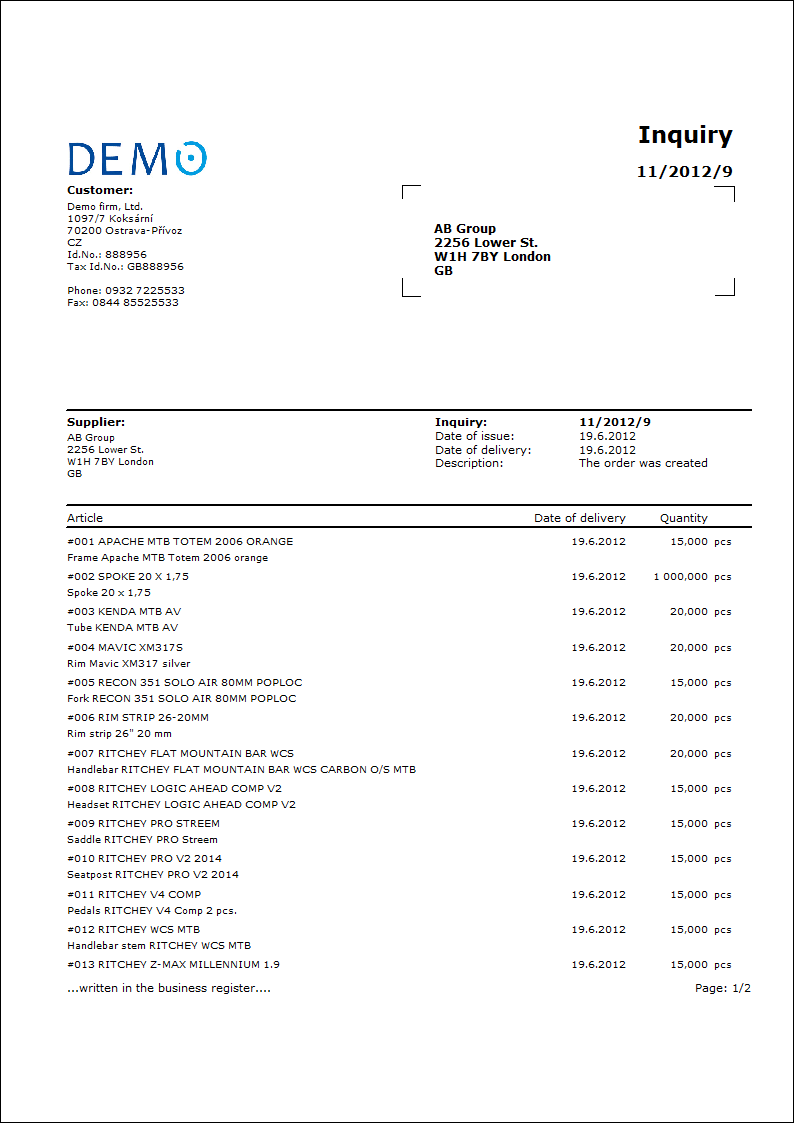
List of orders
Process No.: ZAS004 |
Report ID: SZAS002 |
File: OBV_SEZ01: |
Report description: List of Purchase orders |
||
Address in the tree: [Purchase / Supplying] [Purchase orders] [Print documents - lists] |
||
Report parameters:
Without parameters.
|

Script to create orders for demanded articles
Create orders for demanded articles
Process No.: ZAS003 |
Script Id: FZAS020 |
File: GoodsOrder.PAS |
Description: Creates orders or transfer notes for the requested articles. |
||
Address in the tree: |
||
Script parameters:
PurchBook - ' ' Book of Purchase for Purchase Orders. |
Cooperation - No If a cooperant is set in the production request and the parameters is set to "Yes", the articles will be ordered by default at the cooperant. |
OrderC - '- ' The default code of Purchase Order of a created order. It is inserted only into the document header. |
SelectAll - Yes Marking of the selected articles with asterisks: Yes - all of the loaded items for ordering will be marked with asterisks in the form; No - none of the loaded article items will be marked with asterisks. |
CoverOrder - No Cover sales order codes. Yes - it is ordered in break-up according to the Contract Codes. |
OrderCodeSelect Order the selected code of sales order only. |
CoverBatch - No Cover batches. |
Products - No Yes - order products and semi-finished products; No - they are not ordered. |
DeliveryNotes - No Create delivery confirmation documents according to date. |
ReservCardsOnly - No Only from confirmed reservation sheets. |
UseFilter - No Articles from a container. |
Centre - '- ' A cost centre for the created purchase orders. The cost centre from the document header is also filled in to document items automatically. If the cost centre is already entered on the Article card, a cost centre from another card will be completed into the item. |
FormOfOrder - '- ' Form of a new order. |
DateOfDelivery Delivery date for a new order. |
PaymentMethod - '- ' Payment method for a new order. |
WithdrawalType - '- ' Withdrawal type for a new order. |
TransportMode - '- ' Method of transport of a new order. |
TypeOfTax - 0 Tax type for a new purchase order. By default settings (parameter "GetParamsFirst" = No), it is filled in to the Purchase Order according to the Book of Purchase. If the supplier is set on the Supplier card, it will be filled in preferentially from this card. If the parameter is "GetParamsFirst" = Yes, it must be entered parametrically. Enter the internal number of the requested record. |
ImplicitDelivDays - 0 The default number of delivery days. If the value is higher than 0, this value will be calculated with instead of the number of delivery days from thethe supplier price lists. |
AllPositions - No Yes - even the articles with zero quantity set to order will appear in the form; No - displays only the articles that are actually going to be ordered. |
PlanType - 0 Type of plan (its number) for loading the records from Coverage. Entering the value -1 will load the coverage according to the type of schedule currently set in the Articles book. The plan type if it is not a summation plan is set into the items of the created order. If it is a summary plan or if no plan type is set, then a plan type fromthe relevant Book of Purchase is put into the order items. The Books of Purchase book |
ImplicitDelay - 0 Expected delay of delivery in days. The value is added to the supplier's delivery time. |
ShowIncomingItems - No In the bottom window of the form (Coverage), the incoming items are displayed - types of coverage: Ordered, Planned Delivery, Confirmed Delivery. |
NoInteractive - No Do not display the initial conditions form. |
HideHeaderDetailForm - No Yes - do not display the form for completing the document header of order. No - the form for completing the order header will be displayed. |
SameDelivDate - No Yes - items have the same date as header. |
GetEqualMin - No Yes - if the Article card has the Min and Max defined, it will be ordered even if Avail - Req + Ord = Min. No - ordered only if Avail - Req + Ord < Min. |
Description Description to be inserted into the created document (Purchase Order, transfer note). |
CopyReqAttr - No Yes - ordering according to the requested batch characteristics (article parameters). All data are taken from Coverage (during the activated option Cover Parameters). The requested characteristics are then copied to the order item. The parameter may be combined with the "CoverOrder" parameter for ordering according to the Purchase Order codes. |
GetLastPrice - No Takes the Last price from Article Card. |
IgnoreSupplDelivDays - No Ignore the supplier's delivery time. The planned date of delivery will be identical to the date of ordering. |
IgnoreSupplDelivDays2 - No Ignore the number of supplier's delivery days during the change of date in the form. No - cannot enter lower delivery date than the one suggested according to the number of delivery days. Yes - can enter lower delivery date than the one suggested according to the number of delivery days. |
GetParamsFirst - No Yes - the order will be completed with values from parameters, not from the Customer Card and Book of Purchase. No - the order will be completed with pre-filled values from the Customer Card (Cost centre, Contract code, Payment method, Shipping method, Method of transport) and from the Book of Purchase (tax type). If these values are not filled in, it will be filled in from parameters. |
SupplierFirst - No Yes - prefer default supplier to optimal supplier. |
Stock - 0 Stock presetting for data loading. |
UseFreeCodes - No Yes - activates the Free Contract Codes function. For more details, see the script description. |
FreeCodes ' ' List of contract codes, separated by semicolon, whose disposition is regarded as a free disposition in stock. |
AllowExceedMax - Yes Defines the perspective on the maximum quantity entered in Article card and leads to other formulas for calculating quantity. For more details, see the script description. |
CoverUseDefaultConfig - Yes Yes - loads always after the coverage configuration of the given user. No - loads the coverage configuration set in the "CoverConfig" parameter. |
CoverConfig - ' ' Abbreviation of the concrete coverage configuration according to which to order. In this case, the following parameter "CoverUseDefaultConfig" = "No" must be set. If the entered abbreviation does not find any coverage, the general coverage will load. |
AllowEditPrice - No Enables price editing. Yes - enables editing of unit price in the "Price/UM/C" column. |
SkipWeekends - No Skip weekends. Yes - skips Saturdays and Sundays during the proposal of order and delivery dates.
|
LoadAllPriceLists - No Load all price lists. No - goes only through the price list items whose currency is identical to the currency of the selected supplier. If there is no such code list, a Purchase price from an Article Card is taken and is recalculated to the supplier's currency. Yes - goes through all supplier price lists regardless of currency. The last suitable one will be loaded into the ordering form. |
DaysBeforeUse - 0 Number of days the articles must be delivered before the request has been made for. The value enters the calculation of the latest order date. |
OrderDateFromBehind - No The order date from behind. Yes - The date of order will be set to the value of the latest possible Order Date calculated. The requested delivery date will be identical to the date of the request, or lower by days from thethe "DaysBeforeUse" parameter. No - Date of order is set to current date. |
UseMemorySets - Yes Yes - allows user sorting of columns. No - sorting of columns is not allowed. |
NextOrderDate - No Date of the next order: Yes - the date entered in the initial form is taken as the date of the next order. No - the date in the initial form is the date into which the requests from coverage will be loaded. Detailed description and meaning is described in the text. |
InternalOrdering - No Internal ordering: Yes - a Transfer Note document is created for ordering of articles. No - a purchase order is created for ordering of articles. |
TransAvailableGoods - No Yes - the transfer note is created only for those articles which are available in the supply stock, and only in quantity to the limit of availability. This means that the Transfer Note will contain only the items with a "v" flag. No - the Transfer Note contains all requested Article cards with requested quantity, the items have the "r" flag assigned. |
TransBook - ' ' Book of Warehouses for transfer notes (during internal ordering). |
TransContractCFrom - '- ' "Contract Code From" for Transfer Notes. It is filled into a document header and, in the case of ordering without Contract codes, also into the Transfer Note items. |
TransContractCTo - '- ' "Contract Code To" for Transfer Notes. It is filled into a document header and, in the case of ordering without Contract codes, also into the Transfer Note items. |
TransWarehouseFrom - ' ' "From warehouse" for Transfer Notes (during internal ordering). This is the warehouse of a parent company from which there will be a transfer to branch warehouse (customer). |
TransWarehouseTo - ' ' "To warehouse" for transfer notes (during internal ordering). This is the warehouse of the branch to which we need to deliver the articles. |
UnitFromPriceList - No Stock unit from price list: Yes - the articles are ordered in the stock unit according to the loaded supplier price list. No - the articles are always ordered in the unit default for purchase. |
GrossWeight - No Calculation of weight (from the used stock unit). Yes - net weight; No - gross weight. |
ReqToDate - 00.00.0000 Pre-setting for the Requests to Date field. |
IndependentCoverage - -1 Independence of coverage on the information warehouse. Corresponds to the client parameter with the same name. Values: -1: default value; the script takes the settings from the client parameter; 0 - dependent coverage (parameter off); 1 - independent coverage (parameter on). |
SetPlannedWarehouse - No Yes - the planned warehouse is inserted into the items of the created order (according to the warehouse for which the order was started). In the case of a summation warehouse, the planned warehouse will not be filled. |
By default, the script (parameter "InternalOrdering" = "No") creates an order, in in the case of the parameter "DeliveryNotes" = "Yes" also the document Delivery confirmation.
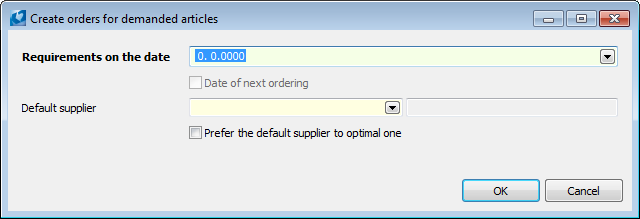
Picture: Initial Form
Field Description of Initial Form:
Requests to date |
The date to which the requested articles should be calculated. The main dialogue displays only the articles which has uncovered requests to a given date and that must be ordered. The date cannot be pre-set by the parameter "ReqToDate" (e.g. to "Today+10 days). If the parameter "NextOrderDate" is set to Yes, the flag of activations becomes checked at the additional text Date of Next Ordering. In this case, the date is not considered to be a date until which the records from coverage are loaded, but as a date on which the personnel plans to order next time. In this case, not only the requests to entered date will be loaded, but also those requests that could not be covered by the next ordering due to delivery times. If the date is still kept at zero during the activation of the parameter, the order will be performed as if the "NextOrderDate" parameter was off. |
Default supplier |
An order for articles with no detected supplier (optimal or cooperant) will be created for this supplier. |
Prefer default supplier to optimal supplier |
The default supplier (set in the Default Supplier field) will be used for the created order regardless of the fact that the articles have its optimal supplier. |

Picture: Create Orders for Demanded Articles form
The form contains articles to order. The proposal to order is the result of processing information from the articles coverage. The script always loads the current coverage of articles according to the settings of "CoverUseDefaultConfig" and "CoverConfig" parameters. If the user wish to ignore some of the specific records (e.g. the Book of documents, minimum quantity), the edited coverage must be loaded.
Each item must be marked with an icon ![]() before ordering and must have an assigned supplier. The priorities to ascertain a supplier for the articles are as follows:
before ordering and must have an assigned supplier. The priorities to ascertain a supplier for the articles are as follows:
- The default supplier set in the initial form of the script and simultaneously activated the option Prefer Default Supplier to Optimal Supplier;
- Page 4 of Article card - Article / Stock Data (only the stock information is take into account, not the information about period);
- Page 1 of Article card - field Optimal Supplier;
- Default supplier entered in the initial form of the script.
If there is no supplier loaded and there are existing supplier price lists for the articles, the supplier from a suitable supplier price list will be loaded. The supplier to the article item may be changed in the form at any time; for further details, see bellow.
More articles to order may be added using the Insert key. The requests for articles and information about the eventual rounding is displayed in the bottom Coverage window. The user may choose not to display the incoming items (items of purchase documents) by using the option Hide Incoming Items. If the light indicator in the columns "Number/Abbreviation/Article Name" is active, we can use the Enter key to switch to the 8th page of the respective Article card (to stock card).
The Select Sales Order button is used to select (mark) contract codes to which to order on. Select the required contract code with the Enter key or use the asterisks to select multiple codes and confirm with the Enter key again. The required codes will be marked with an asterisk in the upper window of the form.
The items whose planned delivery date is later than the reservation date from the Reserving Card (1st page of Reserving Card, the Reserv. Date From field) are marked with an icon of delay ![]() . If the "DaysBeforeUse" parameter is set, it will appear also when the planned delivery date is not lower in the entered number of days than the date of the request (this means that the articles will not be delivered in a sufficient advance before it is required).
. If the "DaysBeforeUse" parameter is set, it will appear also when the planned delivery date is not lower in the entered number of days than the date of the request (this means that the articles will not be delivered in a sufficient advance before it is required).
Description of the columns with dates:
Request date |
Reservation date from the Reserving Card. |
Latest order date |
The last possible ordering date for the articles to arrive in time. It is calculated as a Request Date - number of Delivery Days - value of "ImplicitDelay" parameter (the default delay of deliveries) - value of "DaysBeforeUse" parameter (the number of days in which the articles should be delivered earlier). |
Order date |
The date of ordering. It is linked with Delivery date: if they change, the second value will be automatically calculated. Ordering date is set on a current date by default. If the "OrderDateFromBehind" parameter is set on Yes, then it is preset on a value of calculated date of the latest ordering. However, if this date is already in the past, the current date will be set again. You can change the value manually. |
Delivery date |
Date of requested delivery. The date is filled into the purchase order item. It is linked with the Date of Order: when these are changed, the other value will be calculated automatically. The date is calculated as a Date of Order + number of Delivery Days + value of "ImplicitDelay" parameter (the default delay). May be edited manually. |
The DC (Supplier Price) column with an icon ![]() indicates an item of article that has a supplier price list defined. During the loading of supplier price lists after running the script, only the price lists of an optimal or default supplier are browsed according to the settings of the "LoadAllPriceLists" parameter: either by default those whose currency is identical to the supplier currency, or all of them regardless of the currency. Further details may be found at the parameter in the table. If there is no supplier defined (neither optimal nor default), the last suitable record from the supplier price list will be loaded. To edit a supplier price list, press the Change Suppl. Price List button. The form displays the items of individual supplier prices and also fields for entering new requested quantity. At each item of the supplier price list, the user can see the quantity which is due to rounding actually ordered in the New quantity/UM column. When change the supplier price list, the user can select whether he/she selects only suppliers and selection of a price list leaves on the choice of the K2 system, or whether he/she selects a Price list in his/her own. The Select Supplier and Select a line option are used for that. The Select Supplier option is activated as default. In this case, the user selects only suppliers (he/she indicates a price list with a required Supplier) and after confirmation the selection, the system enters a suitable price list with regard on the ordered quantity. If the option for selection a particular row is activated, the price list that you indicate by the light indicator will be loaded, regardless if a preferable price list for ordered quantity exists.
indicates an item of article that has a supplier price list defined. During the loading of supplier price lists after running the script, only the price lists of an optimal or default supplier are browsed according to the settings of the "LoadAllPriceLists" parameter: either by default those whose currency is identical to the supplier currency, or all of them regardless of the currency. Further details may be found at the parameter in the table. If there is no supplier defined (neither optimal nor default), the last suitable record from the supplier price list will be loaded. To edit a supplier price list, press the Change Suppl. Price List button. The form displays the items of individual supplier prices and also fields for entering new requested quantity. At each item of the supplier price list, the user can see the quantity which is due to rounding actually ordered in the New quantity/UM column. When change the supplier price list, the user can select whether he/she selects only suppliers and selection of a price list leaves on the choice of the K2 system, or whether he/she selects a Price list in his/her own. The Select Supplier and Select a line option are used for that. The Select Supplier option is activated as default. In this case, the user selects only suppliers (he/she indicates a price list with a required Supplier) and after confirmation the selection, the system enters a suitable price list with regard on the ordered quantity. If the option for selection a particular row is activated, the price list that you indicate by the light indicator will be loaded, regardless if a preferable price list for ordered quantity exists.
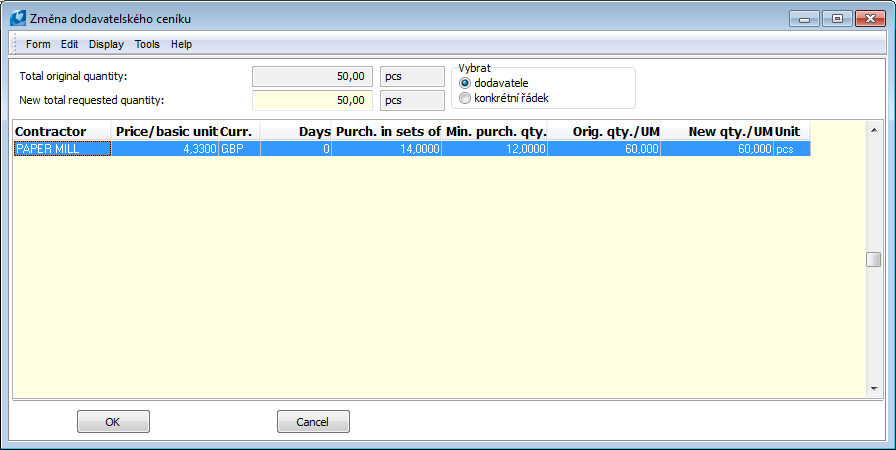
Picture: Change of Supplier Price List form
By the Change Supplier button you can set a supplier from the Suppliers/Customers book to the items. When changing the supplier, a particular quantity for ordering is set (regardless the origin proposed value). Change of the supplier or of the supplier price list will be always executed for records that are indicated by asterisks. In case that you want to change or set the supplier of a current indicated item, use the Supplier editable column. You can open the Change mode by pressing Enter key and open the Suppliers/Customers book.
Important: When ordering according to Contract Codes, the supplier or supplier price list is always changed for the whole combination of Supplier/Articles/Contract Codes.
The CJ (Integer Unit) column with the icon ![]() indicates an item with an integer storage unit. The required quantity is rounded on the whole numbers up in this case.
indicates an item with an integer storage unit. The required quantity is rounded on the whole numbers up in this case.
You can edit the values in all columns that are filled with grey top right corner of the header (e.g. the Supplier, to Order, etc.). Editing the unit price in the Price/UM/M column is conditioned by the "AllowEditPrice" parameter.
For displaying the defined minimum or maximum on the Article cards it is necessary to use the "CF_MinLevelAU/CF_MaxLevelAU" fields that display quantity that is valid for an appropriate warehouse and status is always recalculated for a current selected stock units.
The records in the table can be sorted according to any column. To return to the original sort performed by the Default sorting button.
The Requirements column expresses the total requirement for Articles, it means the reserved quantity and the requirements on minimum/maximum.
If you check the Minimal quantity and Maximal quantity fields on the 4th page of an Article card, another formulas will be used for proposing the quantity for ordering:
- The Article has neither Maximum nor Minimum - the required quantity on the Reserving Cards is decreased about ordered quantity and about the quantity that is already available on the warehouse (Res. - Ord. - Disp.).
- The Article has Minimum (the quantity cannot equal 0) - the required quantity on Reserving Cards is decreased about ordered quantity and disposal plus minimal quantity (Res. - Ord. - Disp. + Min). From this setting the Article is ordered also when there are not reservations on that (from the reason of necessity to cover the requirement on a minimal quantity on the warehouse).
- The Article has Maximum or Minimum and Maximum - maximum that is defined on the Article card can be viewed from two perspectives: as a value that cannot be exceeded, or as an optimal quantity on the warehouse that cannot be exceeded. This is how the field is used in practice in most cases. This difference in view on this field is the reason for using different formulas for calculating quantity for ordering. Set the option of the access by the "AllowExceedMax" parameter (set on "Yes" by default) - the difference is in calculating requirements into the ordered quantity that leads to exceeding the maximum quantity in the warehouse.
- The "AllowExceedMax" = "Yes" parameter - it is ordered only if the Disposal - Requirements + Ordered < Minimum. After that it is ordered by the Max. - Disp. formula. - Ord. + Res.
- The "AllowExceedMax" = "No" parameter - it is ordered only if the Disposal - Requirements + Ordered < Minimum. After that it is ordered by the Max. - Disp. formula. - Ord.
If the minimal or maximal quantity is defined for individual warehouses (4th page of the Article card, bottom window), the script orders according to values set for the given warehouse and period (month/s). Current date is decisive during the calculation of minimum/maximum. If the minimum and maximum is not set for individual warehouses, then the quantity is ordered for Article card (according to the Minimum quantity and Maximum quantity fields).
Designed quantity consequent from the requirements is rounded according to these data in the case that it is ordered at a supplier about which you keep a record in the supplier price list. And at the first time pursuant to the Minimum purchase quantity field and followed pursuant to the Purchase in sets of field (it is always rounded upward).
The script enables to notify a user on free position on other contract codes in the case of ordering according to the Contract Codes. For activation of the function it is needed to set the parameters: "CoverOrder" = "Yes", "UseFreeCodes" = "Yes", "FreeCodes" = to fill contract codes of which the disposal will be considered as free disposal on a warehouse. If the free position exists for an article, the article is displayed in the form show place ![]() , has in column “with” icon
, has in column “with” icon ![]() and suggested quantity to ordering is zero. The free disposal can be displayed by the "CF_FreeDisp_MJ" column. However, the transfers between contract codes are not solved by the script.
and suggested quantity to ordering is zero. The free disposal can be displayed by the "CF_FreeDisp_MJ" column. However, the transfers between contract codes are not solved by the script.
Another option is to display a column that will notify the user of the ambiguity of supplier for the item (different suppliers are forced in the sales items). In this case, the column will show the icon ![]() It is the "CD" column (more suppliers) with the "BMP_MoreSupp" program name. The script only signals the existence of more possible suppliers. In case that the user did not resolve the ordering the item, the coverage of the item will be executed from an existing disposal standardly and the Order will be created on the optimal supplier.
It is the "CD" column (more suppliers) with the "BMP_MoreSupp" program name. The script only signals the existence of more possible suppliers. In case that the user did not resolve the ordering the item, the coverage of the item will be executed from an existing disposal standardly and the Order will be created on the optimal supplier.
The script orders according to the specific loaded coverage (see the Configuration of Coverage in the Articles book). Which coverage will be loaded is set by the "CoverUseDefaultConfig" and "CoverConfig" parameters.
If you set the "NextOrderDate" parameter on "Yes", you can change the principle of loading records for coverage according to the date that has been set on the initial form. If you activate the parameter, the defined date is the date of the next ordering. (This is indicated by checking the checkbox at the additional text - Date of next ordering on the form. In this case, not only the records to the defined date are loaded, but also those after the date; however,because of delivery time, they could not be covered when next ordering, are loaded from coverage. So, in general, it is determined for each article according to the loaded supplier price list, which delivery time has and this delivery time is added to the defined date for this Article. For ensuring the delivery time of Articles, a suitable supplier price list is searched according to the rules: it is searched the price list for an optimal or a default supplier with the zero quantity, if the optimal or the default supplier is not set, then another with the zero quantity and further with regard on the "LoadAllPriceLists" parameter. If the supplier is not set and more price lists with the zero quantity and with a various delivery date exist, then the price list with the shortest delivery time will be loaded.
You can save the masks of columns in the form standardly in the menu of Display - Masks of columns form.
By the Coverage button in the lower part of the form, you can display the Coverage standard function; by the Document button, you can switch to a current document according to the type of the record on that the light indicator is positioned in the Coverage window (a document, 4th page of Article card, book of Articles).
Create the Order respectively Orders (if there are indicated the articles with various suppliers) by pressing the Order button. If you have indicated the items with a various currency, a query will display, if you want to create all Orders into the identical Purchase book. If you answer yes, the form for setting the parameters of an Order, if you answer No, then you return into the proposal order.

Picture: Parameters of Orders form
In the form, the user is offered the options of the creation of filter of orders: you can select whether a new filter of orders will be created, or if the already created Orders will be added to an already existing filter.
After creation the Orders the system informs you about number of newly created documents.
Ordering within the company (by Transfer Note)
When setting the "InternalOrdering" to "Yes", the required Article will be ordered by the Transfer Note document. Requirements on Articles are loaded simultaneously as when ordering by the Orders with the difference that the Suppliers are not loaded and the rounding of quantityto order is not executed. Purchase Order The Planned stock price from an Article card is loaded as the Price. The items of the Transfer Note are created with the Reservation "r" flag and into the Reserved field the Delivery Term is entered from the item of an Ordering form.
Using the parameter "TransAvailableGoods" = "Yes" can ensure only the transfer of articles that are available in the supply stock. Further description of the script may be found in the parameters table.
For creation the Transfer Notes it is necessary to set the "TransBook", "TransWarehouseFrom" and "TransWarehouseTo" parameters that are empty as default.